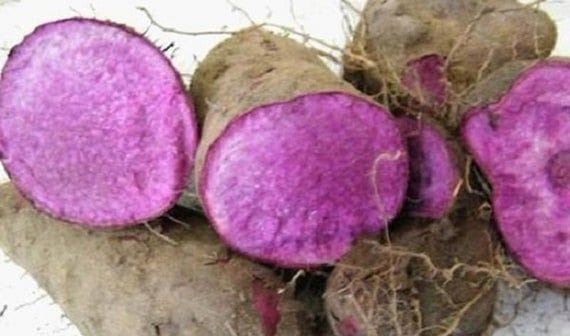In the provinces, “ubi” or purple yam is consumed as boiled root crop and as an ingredient to local dishes and sweets. Today, this root crop is also gaining popularity as flavoring and ingredient to a wide array of food products – from ice cream to cakes to candies to wines, etc.

Ubi or purple yam is considered as minor commodity in the Philippines though, its commercial potential recognized. Ubi has many uses and can be utilized as both fresh tubers and processed products. It is an essential carbohydrate food with starch as its main component. It also contains sucrose and glucose which provide its sweet flavor.
Aside from the starch and sugar contents of ubi, which makes it perfect for baking and confectionery preparations, it also has the essential proteins, phosphorus, crude fiber, ash and vitamins B1, B2, E and also moisture and energy. Health wise, these components make ubi comparable to other viable root crops such as cassava and sweet potato. It also makes a good alternative for rice, corn and legumes.
In the Philippines, Bohol is the leader among provinces in terms of ubi production. The older Boholanos consider ubi as their sacred food since according to them, it sustained them during times of long drought and saved them from hunger. Ubi is now widely marketed in powdered form and as puree and has an increasing demand in countries like Australia, Canada, Taiwan, Japan and the US.
Tagged as one of the country’s five major root crops for export, it is but right for ubi to receive its due attention in terms of its production and marketing. Although Bohol is the largest ubi producer in terms of hectarage, there are reports of the decline in production and export. Problems and constraints that beset production hinder ubi from reaching its full potential as a major high-value crop.
BAR support
The Bureau of Agricultural Research (BAR) provided financial support for the Ubi Agribusiness Development Project of the Department of Agriculture RFU 7 – Central Visayas Integrated Agricultural Research Center (CENVIARC). This project is aimed at increasing the volume of ubi production and enhancing the development of the ubi production industry in Bohol with new production standards.
Three varieties of ubi grown in Bohol were covered in this study – “kinampay,” “baligonhon,” and VU-2.
In the course of project implementation, various agribusiness components of management such as planning, production, post-harvest and marketing were undertaken. With considerations for ubi as an economically feasible commodity for agribusiness venture, fifty farmer-partners from the municipalities of Guindulman and Dauis were identified as recipients of technical and financial assistance for ubi production. Farmers training, procurement of farm inputs, farm establishment, monitoring and evaluation and field days were then conducted.
Market systems were designed to increase the absorption of ubi products in the market. These market systems minimized the involvement of middlemen and facilitated direct marketing of ubi from the farmers to the direct buyers. This was done through linkaging with target markets and participation in agro-fairs and the ubi festival celebration.
The 50 farmer-partners who were chosen to participate in the project used a new and improved package of technology on ubi. Two methods were used in land preparation – the ridge method and the hill method. The project also dealt with the preparation of planting materials or ubi-setts, planting, fertilizer application, mulching, weeding, pest and disease control, harvesting, and storage. The yield, income and cost of production were used as parameters in the study.
Positive results
With favorable results attained, the implementation of this Agribusiness Development Project was turned over to the farmer’s association in the towns of Guindulman and Dauis in Bohol. Repayment received for planting materials, fertilizers and other inputs was turned over to the farmer’s organization which is now managing the roll over scheme.
As of today, the farmers are enjoying increased farm income because of the improved production efficiency. They were able to reduce the farm post-harvest losses. The share of the farmers in the final market price was increased because of the direct marketing system. While the farmers enjoy bigger earnings, the consumers take pleasure in what have become everybody’s favorite ubi products. It can be said that ubi powder, fried ubi chips, yam spread, ubi jam, ubi pastillas, and other ubi products have brought contentment to the producers, processors and consumers of ubi.
Source: Dondon Carlo P. Lejano, Bardigest January-March 2009 Volume 11 Issue No. 1
